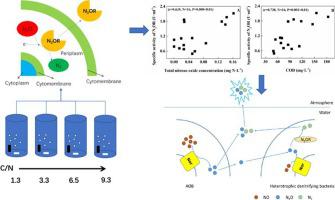Journal of Water Process Engineering ( IF 6.3 ) Pub Date : 2021-04-26 , DOI: 10.1016/j.jwpe.2021.102090 Rui Yang , Lin-jiang Yuan , Ru Wang , Zhi-xian He , Xi Chen

|
Nitrous oxide reductase (N2OR) (EC 1.7.2.4) is the only enzyme that can catalyze nitrous oxide (N2O) decomposition to nitrogen gas, which connects tightly with N2O accumulation. But it is known little about N2O metabolism based on the enzyme in biological nitrogen removal of wastewater, especially in aerobic conditions. This paper studies the biosynthesis and metabolism of N2O through the analysis of the activity of the enzyme in aerobic conditions. It is revealed that the main metabolic mechanism of N2O was heterotrophic denitrification, which was mainly affected by electron supply (the amount of organic matter) and the external environment (pH value), while the escaped N2O mainly came from nitrifiers. This indicates that the primary reason for the emission of N2O in the aerobic phase was that the N2O consumption rate of heterotrophic denitrifiers was lower than the N2O production rate of nitrifiers. Considering the removal efficiency of nitrogen, the enzyme activity and the reduction of N2O emissions, it is feasible to keep the C/N ratio of inflowing around 6.5 in A/O SBR.
中文翻译:

在有氧条件下调节N 2 O产生的新见解:基于一氧化二氮还原酶酶促分析的N 2 O代谢观点
一氧化二氮还原酶(N 2 OR)(EC 1.7.2.4)是唯一可以催化一氧化二氮(N 2 O)分解为氮气的酶,该酶与N 2 O的积聚紧密相连。但是,基于酶的N 2 O代谢在废水的生物脱氮方面,尤其是在有氧条件下,还知之甚少。通过分析好氧条件下酶的活性,研究了N 2 O的生物合成和代谢。结果表明,N 2 O的主要代谢机制是异养反硝化作用,主要受电子供应(有机物含量)和外部环境(pH值)的影响,而逃逸的N2 O主要来自硝化器。这表明在好氧阶段排放N 2 O的主要原因是异养反硝化器的N 2 O消耗速率低于硝化器的N 2 O生成速率。考虑到氮的去除效率,酶活性和N 2 O排放的减少,在A / O SBR中将流入的C / N比保持在6.5附近是可行的。















































 京公网安备 11010802027423号
京公网安备 11010802027423号